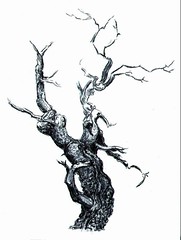Édouard Vuillard (French Nabi/Post-Impressionist painter - 1868-1940) was another artist who was taken with photography. In the mid 1890s, he acquired a simple Kodak camera which he used as a help in composing his pictures (as well as to take snapshots of his family and friends). "What was interesting in this connection was the role the camera played in distorting, foreshortening, perspectival riddles, and in the cropping of pictures frames" according to the same article.
Indeed, many of Vuillard's pictures have very unusual compositions that look as though they could have been inspired by "snapshot" views. He did not, however, paint exactly what his camera saw; rather he used photographs as reference and rearranged elements to suit his fancy.
"His paintings are never mere copies of photographs. Always, changes in emphasis and in the handling of light transform the photographic aide-memoire into a poignant work of art." (Quote is from the Carrick Hill website.)
Square Berlioz (aka La Place Vintimille)
Édouard Vuillard - 1915
Oil on canvas - 17.72" X 29.88" (45 cm X 75.9 cm)
Source: the-athenaeum.org
The painting shown above of "La Place Vintimille" is a view from the window of Vuillard's apartment on the second floor.
"Vuillard took many photographs of Place Vintimille, from his fourth-floor windows beginning in 1909 and, after he moved in 1913, from the second floor of the same building" according to this article in Art in America.
In this article on the Christie's auction site, it states that after Vuillard became familiar with photography, there was a difference in how his pictures looked, including the use of "optical foreshortening" and "radical cropping."
In this review on the "New York Art World" site about a Vuillard exhibition at the National Gallery of Art in 2003, it states that more than 2,000 photographs taken by the artist have survived.
It seems odd to me that some see quite a lot of influence of photography on Vuillard's paintings, but others see very little. Here is an article in Slate Magazine on Édouard Vuillard (and other artists of his time) and photography that minimizes the part photography played in Vuillard's artwork, explaining that he bought his camera mainly for the purpose of taking snapshots of friends and relatives. It is admitted, though, that Vuillard did utilize the camera as a tool at times, to help him with "details" in some of his paintings. The author brings up something that hadn't occurred to me, which is the idea that it must have been unsettling for Vuillard to try to compose pictures (with his camera) that were not going to be seen in colors, but in black, white, and grays; and therefore he wouldn't have been inclined to think of his photographs as "art" -- but it seems to me that that is beside the point (which is that he did or did not use material from some of his photographs as aids in making some of his paintings -- There is no reason at all for photographs to be "artistic" in order to be of this kind of use).
This is the third in a series on artists and photography. Here are the others (and there will be more in the future):
Edgar Degas and Photography
Eugène Delacroix and Photography


0 comments:
Post a Comment